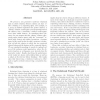Free Online Productivity Tools
i2Speak
i2Symbol
i2OCR
iTex2Img
iWeb2Print
iWeb2Shot
i2Type
iPdf2Split
iPdf2Merge
i2Bopomofo
i2Arabic
i2Style
i2Image
i2PDF
iLatex2Rtf
Sci2ools
93
Voted
ICDM
2007
IEEE
2007
IEEE
Data Clustering with a Relational Push-Pull Model
We present a new generative model for relational data in which relations between objects can have either a binding or a separating effect. For example, in a group of students separated into gender clusters, a “dating” relation would appear most frequently between the clusters, but a “roommate” relation would appear more often within clusters. In visualizing these relations, one can imagine that the “dating” relation effectively pushes clusters apart, while the “roommate” relation pulls clusters into tighter formations. A unique aspect of the model is that an edge’s existence is dependent on both the clusters to which the two connected objects belong and the features of the connected objects. We use simulated annealing to search for optimal values of the unknown model parameters, where the objective function is a Bayesian score derived from the generative model. Results describing the performance of the model are shown with artificial data as well as a subset of th...
Related Content
| Added | 03 Jun 2010 |
| Updated | 03 Jun 2010 |
| Type | Conference |
| Year | 2007 |
| Where | ICDM |
| Authors | Adam Anthony, Marie desJardins |
Comments (0)

